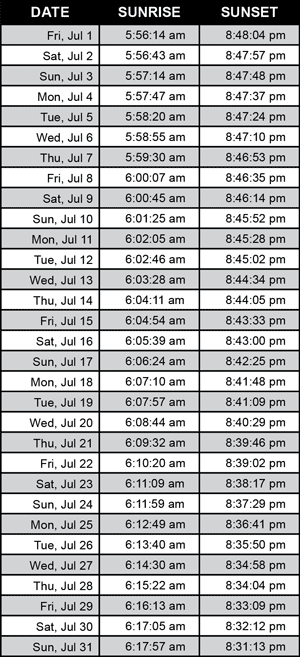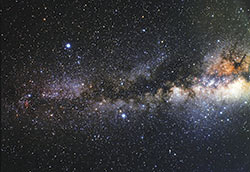DARK SKY HAPPENINGS - July 2022
Moab
UT (at City Hall)
38O34’ N Latitude
109O33’ W Longitude
4048 ft - 1234 m |
Observe the Milky Way and Great Rift
by David Prosper, NASA Night Sky Notes
Sunrise-Sunset
(The time of sunrise and sunset assumes a flat horizon. Actual time may
vary depending upon the landscape.) |
 |
Summer skies bring glorious views of our own Milky Way galaxy to observers blessed with dark skies. For many city dwellers, their first sight of the Milky Way comes during trips to rural areas - so if you are traveling away from city lights, do yourself a favor and look up!
 To observe the Milky Way, you need clear, dark skies, and enough time to adapt your eyes to the dark. Take note that, even in dark skies, the Milky Way isn’t easily visible until it rises a bit above the horizon and the thick, turbulent air which obscures the view. The Milky Way is huge, but is also rather faint, and our eyes need time to truly adjust to the dark and see it in any detail. It’s best to attempt to view the Milky Way when the Moon is at a new or crescent phase; you don’t want the Moon’s brilliant light washing out any potential views, especially since a full Moon is up all night. To observe the Milky Way, you need clear, dark skies, and enough time to adapt your eyes to the dark. Take note that, even in dark skies, the Milky Way isn’t easily visible until it rises a bit above the horizon and the thick, turbulent air which obscures the view. The Milky Way is huge, but is also rather faint, and our eyes need time to truly adjust to the dark and see it in any detail. It’s best to attempt to view the Milky Way when the Moon is at a new or crescent phase; you don’t want the Moon’s brilliant light washing out any potential views, especially since a full Moon is up all night.
Keeping your eyes dark adapted is especially important if you want to not only see the haze of the Milky Way, but also the dark lane cutting into that haze, stretching from the Summer Triangle to Sagittarius. This dark detail is known as the Great Rift, and is seen more readily in very dark skies, especially dark, dry skies found in high desert regions. What exactly is the Great Rift? You are looking at massive clouds of galactic dust lying between Earth and the interior of the Milky Way. Other “dark nebulae” of cosmic clouds pepper the Milky Way, including the famed Coalsack, found in the Southern Hemisphere constellation of Crux. Many cultures celebrate these dark clouds in their traditional stories along with the constellations and Milky Way.
MOON HAPPENINGS
July 6 - First Quarter at 6:14pm
July 13 - Full Moon 10:38am
July 20 - Last Quarter at 6:19am
July 28 - New Moon at 9:55am |
Moab Dark Skies mission is to promote the appreciation and conservation of Moab’s valuable and rare dark skies. Moab Dark Skies was established by the Friends of Arches and Canyonlands Parks in conjunction with the National Park Service and Utah State Parks Division of Natural Resources
For more information, check out our Facebook page. |
|